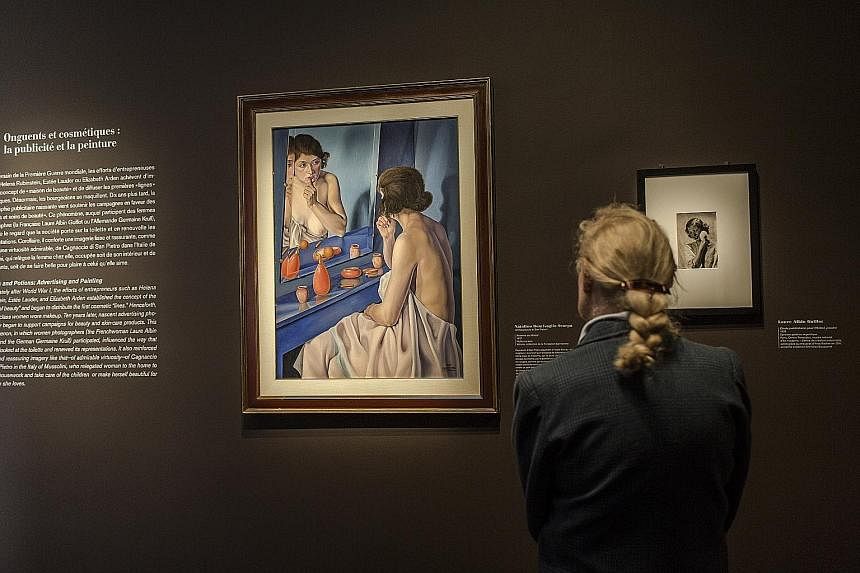Paris - A woman undressing to take a bath is at her most vulnerable - alone, half-nude, self-absorbed, unprepared for prying eyes.
For centuries, however, women experienced the ordinary act of washing in less than complete solitude.
Women of a certain class were rarely alone, even when attending to the most intimate parts of their bodies. Their lives were, in a sense, communal property, especially those of wealthier women who until the mid-19th century were the ones most frequently depicted in artwork, although prostitutes and mistresses were also subject matter.
The evolution of how women experienced bathing and grooming - and how artists portrayed those moments - is the subject of a thought-provoking exhibi- tion at the Musee Marmottan Monet in Paris.
The show, La Toilette: The Birth Of Privacy, brings together more than 100 works, including paintings, etchings and drawings, that reflect the most private moments in a woman's day, as she washes her hair, buttons her dress and - in a couple of paintings that might appeal to the more prurient viewer - urinates and shows her bare buttocks.
With works from as early as 1500 and as recent as the 1990s, the show - which runs till July 5 - is as much social history as art history, tracing how long it took for women to possess private space.
Though some of the material is first-rate, the exhibition's greatest strength is illuminating themes that resonate even today, not least the elusiveness of privacy and the way the modern era of selfies and Internet sharing has made hard-won private moments public again.
For Mr Georges Vigarello, one of the curators, the show brings together ideas about how our forebears saw their bodies.
He said: "When we look at these works, we are looking at ways of seeing and feeling that are completely different from our own."
At the same time, the rituals surrounding bathing have not diminished.
"This history is interesting because it makes us ask ourselves about our own cleaning practices and what we do and why we feel so strongly about it, and it makes us wonder how it will change over time."
He said the show's goal was to trace the depiction of the act of "la toilette", or preparing oneself for the day, from the late Renaissance period up to the contemporary era.
He and the exhibition's other curator, Ms Nadeije Laneyrie-Dagen, chose a Flemish tapestry from around 1500 as one of the opening works because it is one of the earliest examples of a bathing scene that shows a mostly naked woman depicted as neither goddess nor biblical figure.
The woman appears nude except for a diaphanous cloth she seems to have draped below her waist, which is submerged in water. She does not seem at all shy despite the presence of no fewer than five attendants, two of whom are men.
The woman is clearly of the nobility, as she is attended by servants and wears jewels. In the 1500s, Mr Vigarello said, only a noblewoman would have the privilege of taking a bath.
The water would almost certainly have been cold and there are no signs of soap or anything with which to scrub the body. Cleaning at the time was believed to have been done as much with salves and herbs and flowers that scented the body as with water, he added.
With the exception of the occasional pitcher used for rinsing hands or washing feet, it seems that most people did not wash much. Social historians believe that a bath was something many people could afford only a couple of times a year - if that often.
"People didn't have access to water, but there were also reasons that people didn't want to use it," said Mr Steven Zdatny, a social historian of modern France who teaches at the University of Vermont and is writing a book on the history of hygiene.
Homes and water were mostly unheated and people feared catching a cold or disease. Instead, they washed parts of themselves - hands, feet, or even, as is shown by the use of bidets, their private parts, Mr Zdatny said.
As late as the mid-1800s, people in France were still renting bathtubs, which had to be brought to the house by strong-armed men, filled with water lugged in pails, often from outdoor wells and, when possible, heated on stoves and then disposed of.
Throughout the 17th and 18th centuries, multiple people, including servants and callers, assisted wealthy women as they dressed for the day.
Poorer women and those who were probably prostitutes were more often depicted alone. In the 19th century, water became more plentiful, as did indoor plumbing. By 1870, the bathroom has appeared in art as it did in middle-class society.
In some paintings, women can be seen leaning over sinks or lingering in their brimming baths, sponging an extended leg. Most important, they are finally alone.
It is with the graceful portraits of Pierre Bonnard - there are three in the show - that women finally not only possess their bathrooms and the space in front of their mirrors, but also appear to have become the central force in determining how the painter sees them.
In one Bonnard painting, a woman is submerged in a bath, her body almost merging with the water, which shields her from prying eyes and also makes her one with an elemental force of life.
It is a painting that suggests at least one reason that depictions of women in art can be so alluring. Their bodies may or may not be exposed, but something of their essence remains a mystery.
New York Times

